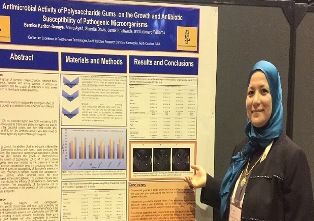Day 2 :
Keynote Forum
Gregory Lambert
TargEDys, France
Keynote: Probiosatys – naturally modulating the appetite via the microbiome
Time : 09:00-09:45

Biography:
Pharmacist and Ph.D. in pharmaceutical technology, Gregory LAMBERT carrier is split between Biotech and Pharma where he occupied the positions of Chief Scientific Officer and Chief Executive Officer in companies such as Novagali Pharma, Septodont and currently TargEDys. Gregory drove the development of several products from the laboratory to market authorizations. In 2014, Gregory joined the scientific founders of TargEDys as CEO. Having completed its preclinical development and produced industrial batches, TargEDys now concentrates on human clinical trials and commercial launch activities.
Abstract:
TargEDys is a French biotech company aiming to control metabolic disease by modulating the appetite through an intervention on the microbiome. TargEDys’ innovative, satiety inducing technology (ProbioSatys), is based on a unique understanding of appetite regulation at the molecular level. Bacteria can send signals of satiety to the brain from the gut by molecularly mimicking satiety hormones, thus activating natural satiety pathways. This gut-brain axis is the bidirectional communication between the central and enteric nervous systems, linking the emotional and cognitive centres of the brain with peripheral intestinal functions. Gut bacteria are very important in influencing these interactions.
The basis of TargEDys’ ProbioSatys technology is a commensal, enterobacteria probiotic strain, Hafnia alvei, that produces the ClpB protein. ClpB is a mimetic of the satiety hormone (α-MSH) that regulates food behaviour at both peripheral and central levels. When released, ClpB directly stimulates the intestinal enteroendocrine L-cells to produce satiety hormones. ClpB also enters the bloodstream to act on satiety regulation in the central nervous system by mimicking α-MSH. The resulting effect is the feeling of satiety or fullness after a meal. The mechanism of Hafnia has been proven preclinically in vitro and in vivo and is currently being tested in humans. This probiotic will be launched as a food supplement in April 2019. The preclinical results indicate that after 3 months of treatment customers can expect to safely lose 3-5% of their body weight, see a 5-10% reduction in food intake, improved body composition and activation of lipolysis.
Keynote Forum
Arthur C Ouwehand
Danisco, Finland
Keynote: Probiotics in the management of bacterial vaginosis
Time : 09:45-10:30

Biography:
Arthur C Ouwehand received his B.Sc. in Biology and Chemistry in Utrecht (the Netherlands) 1987, his M.Sc. degree (1992) in cell biology from Wageningen University (the Netherlands) and his Ph.D. degree (1996) in Microbiology from Göteborg University (Sweden). Since 1999 he is Adjunct Professor in Applied Microbiology at the Turku University (Finland) and since 2004 he has been working for Danisco; now DuPont Nutrition and Health. He is the author of more than 250 journal articles and book chapters; he is the Editor of four books on lactic acid bacteria and the intestinal microbiota and co-inventor on 15 approved patents.
Abstract:
Bacterial vaginosis (BV) is a common condition that affects most women at some stage. BV is characterised by reduced levels of vaginal lactobacilli and an over growth of e.g. Gardnerella vaginalis and Atopobium vaginae. This imbalance is used in diagnosis with the so-called Nugent-score. Probiotic lactobacilli have been investigated as an adjunct to antibiotic treatment and shown to be successful. However, most studies have investigated the effect of vaginally applied probiotics. Here, I report on the oral use of probiotics in BV. Two-week consumption of a combination of Lactobacillus rhamnosus HN001 and Lactobacillus acidophilus La-14 by healthy women, resulted in vaginal colonisation in 85% of the women. Interestingly, colonisation still increased in the week after consumption was stopped. In vitro studies have shown that both strains and in particular L. acidophilus La-14 produce hydrogen peroxide; an important antimicrobial involved in the stabilisation of a healthy vaginal microbiota. Both strains were also shown to inhibit the growth of G. vaginalis and A. vaginae in vitro and prevented experimental vaginosis in mice. In a subsequent human study, 40 women with borderline BV, as judged by Nugent-score of 4-6 and vaginal symptoms were randomised to receive either probiotic treatment or placebo for 15 days. In the probiotic group, Nugent-score improved to below 3 (no BV) with no change in the placebo group. Symptoms of itching and vaginal discharge also improved significantly in the probiotic group. The combination of L. acidophilus La-14 and L. rhamnosus HN001 is beneficial in the management of BV.
Keynote Forum
Cliff Shunsheng Han
Knoze Jr Corp, USA
Keynote: Prebiotics induced oral microbiota changes to accompany long-lasting allergy relief

Biography:
Cliff Shunsheng Han is a Biologist for 28 years and a former medical doctor and the inventor of AllerPops. He had been a Biologist in Los Alamos National Laboratory (LANL) for 22 years, where he participated the Human Genome Project, led a team to complete many hundreds of bacterial genomes and authored more than 300 research papers. Before that, he got his PhD from Fudan University, was trained as a medical doctor in China and worked in a mental hospital for four years.
Abstract:
Statement of the Problem: The hygiene hypothesis has been proposed to explain the increase of allergy diseases for 28 years. Many studies on personal and social hygiene practices suggest their association with the prevalence of allergy diseases. However, attempts to using probiotics to cure or prevent allergy diseases have had limited effects. This study is to demonstrate that not having enough oral probiotics causes allergic rhinitis.
Methodology & Theoretical Orientation: Saliva samples were collected from a subject for 3 years during which time the subject experienced yearlong allergy, seasonal allergy and remission of allergy symptoms. Bacterial DNA was extracted and 16S rRNA genes were profiled with Illumina sequencing technology.
Findings: I found that Veillonella and Streptococcus were less abundant when allergy symptoms were worse and more abundant
in family members without allergies. A composition made to stimulate the growth of these bacteria can relieve allergy symptoms
temporarily. A combination of substantial removal of the oral biofilm using physical means, including a local pyrotherapy and
usage of the composition leads to long-lasting remissions of allergy symptoms. These results indicate that one of the major causes of allergic rhinitis is likely the lack of metabolites from mutualism between Veillonella and Streptococcus, such as short chain fatty acids. Restoring the abundance of these bacteria may alleviate or even cure the disease. The easy destruction of oral biofilm by a moderate fever indicates a possible natural negative trigger that subsequently increases the efficacy of the immune system previously restrained by metabolites from microbiota. I name this mechanism as Theory of Negative Trigger. This mechanism could explain how fever increases immunity and helps the body fight infections and even cancers.
Keynote Forum
Peter Leighton
ProSperity Bioscience, USA
Keynote: Functionally targeted probiotics: Optimizing human wellness
Time : 11:45-12:30

Biography:
Peter Leighton is the CEO of ProSperity Bioscience and founding partner of Abunda Functional Foods, an integrated consulting group. Leighton brings 30 years’ experience in consumer products, nutraceuticals and biotechnology. Responsible for some of the most successful brands on the market, Leighton has been a thought leader in the areas of functional foods and science-based nutraceuticals. Leighton has held senior executive positions with Complete Nutrition, Advana Science, Natrol (NTOL), Galileo Laboratories, Metabolife and Weider Nutrition (WNI).
Abstract:
The revolution has begun. A revolution in wellness and consumer products that is opening a new approach towards human health. With the adoption of DNA sequencing, a whole new world has opened up, allowing researchers to identify specific strains of bacteria. Combined with the informatics revolution, mass data gathering projects such as The Human Food Project, Human Microbiome Project and others are mapping the diverse microbial environment to changes in health. Mr. Leighton will identify how the next generation of well-adopted consumer nutrition products will be probiotic based; how these Functionally Targeted Probiotics will have a dramatic positive impact on consumers and the strained healthcare system; and what the emerging science is showing us about microbiome-based wellness. Mr. Leighton will assess the changing perspectives of consumers and how these trends directly intersect with advances in probiotics research.
- Future of Probiotics and Prebiotics| Genomics of Probiotics and Prebiotics| Probiotics Nutrition| Probiotics in maintaining Health| Microbiome and Probiotics
Location: USA

Chair
Cliff Shunsheng Han
Knoze Jr Corp

Co-Chair
Arthur C Ouwehand
Danisco, Finland
Session Introduction
Arthur C Ouwehand
Danisco, Finland
Title: The future of probiotics: Using trial registries as a crystal ball
Time : 12:30-13:00

Biography:
Arthur C Ouwehand received his B.Sc. in biology and chemistry in Utrecht (the Netherlands) 1987, his M.Sc. degree (1992) in cell biology from Wageningen University (the Netherlands) and his Ph.D. degree (1996) in microbiology from Göteborg University (Sweden). Since 1999 he is Adjunct Professor in Applied Microbiology at the Turku University (Finland) and since 2004 he has been working for Danisco; now DuPont Nutrition and Health. He is the author of more than 250 journal articles and book chapters; he is the editor of four books on lactic acid bacteria and the intestinal microbiota and co-inventor on 15 approved patents.
Abstract:
Probiotics and to lesser extent prebiotics, have been widely used over the past 25 years. However, with the increased capabilities in microbiome research and associated fields such as proteomics and metabolomics, these product groups
have gained interest and new potential targets are being identified. There is also an increased understanding in the mechanism by which these ingredients work, which is expected to lead to the development of better targeted, more efficacious and more versatile probiotics and prebiotics. Microbiome techniques are also providing opportunities for identifying novel so-called next
generation probiotics, from new genera and species. Similarly, new prebiotic components will be identified; targeting different organisms then the usual lactobacilli and bifidobacteria. To understand where the pro- and prebiotic research fields are going, one can look data bases such as PubMed or in patent data bases; these, however, only allow us to look back at research that has been done. Doing a similar exercise with clinical trial registries may provide us a peek into the future; what intervention studies are being planned. We will see that some clinical end-points have reached maturity while other continue to attract attention and new end-points gain interest. In any case, the area of pro and prebiotics is very much alive and follows the technological developments. It is expected that this will translate itself into the products we will see on the market in the future.
Robert H Schiestl
University of California at Los Angeles, USA
Title: Novel probiota reducing inflammation in the entire body and persisting in the human intestines at least 60 days
Time : 14:00-14:30

Biography:
Robert H Schiestl received his PhD from the University of Vienna, Austria at the age of 23. He did Postdoctoral work in Edmonton, Alberta, Rochester NY and Chapel Hill, NC. He was Professor at Harvard with the age of 31 where he stayed for 10 years. Since 18 years he is Professor at UCLA.
Abstract:
When our lab moved from Harvard to UCLA we found a huge difference in genetic instability and longevity in our Atm deficient mice after 5 years. When we changed the intestinal microbiota back to conventional microbiota we could reproduce the phenotype at Harvard. We tested Atm deficient mice for genotoxicity, genetic instability, DNA damage, inflammation markers, cancer latency and longevity and high throughput sequencing of the intestinal microbiota. Isogenic mice with different microbiota showed a four fold difference in life expectancy, a 4.5 fold difference in genetic instability and DNA damage. The onset of lymphomas was significantly 2.5 fold different. We sequenced the microbiota and found a Lactobacillus johnsonii 456 (LBJSupra) strain as dominant bacterial strain in the health beneficial microbiota. Just this bacterium by itself reduced genotoxicity, reduced inflammatory cytokines, induced anti-inflammatory cytokines and significantly reduced levels of cytotoxic T, CD3 and natural killer cells in the spleen, liver and blood. We also found similar differences in Trp53 deficient and even in wildtype mice. The underlying mechanism is due to inflammation promotion or suppression mediated by the intestinal microbiota. We did a clinical trial with this Lactobacillus strain that makes a great yogurt. 13 people took it for 7 days
and all of them had an increase of Lactobacilli in their feces, 7 of them had the same increase after 30 days and 4 of them 60 after days which is unique. This is because it expresses 16 proteins that bind to mucus which is also unique and it binds to human intestinal cells and thus inhibits binding of pathogens like Salmonella and pathogenic E. coli. It also expresses bacteriocins that kill pathogenic bacteria like Salmonella and pathogenic E. coli but not beneficial bacteria. LBJsupra is completely resistant up to PH 2 and pepsin, is at 100% viability in yogurt after 250 days in the fridge and can be scaled up for production. Inflammation is involved in most deadly diseases such as heart disease, cancer, neurodegenerative disease, inflammatory bowel disease,ulcerative colitis, Lupus, Crohn’s disease, Celiac disease, artheriosclerosis, arthritis, fibrosis, asthma and Diabetes and autism.
Amira Ayad
The North Carolina Research Campus, USA
Title: Stimulating the viability of Bifidobacterium spp. in synbiotic fermented milk by co-culturing with Lactobacillus paracasei 441 and inulin
Time : 14:30-15:00

Biography:
Amira A Ayad, Ph.D, is a Research Associate in the Food and Nutrition Sciences program at the North Carolina Agricultural and Technical State University-Center for Excellence in Post-Harvest Technologies. In this position, she taught several courses related to food analysis and food microbiology. Her research has focused on two main areas: Food Fermentation and Food Safety. Our research group focused on studying the fermentation processes of microorganisms like bacteria and how probiotic cultures as functional foods could influence the gut health and eventually human health. In addition to that, our research groups focus on studying natural antimicrobial properties against foodborne pathogens.
Abstract:
Bifidobacterium spp. and Lactobacillus spp. are probiotic bacteria have been incorporated in dairy-fermented products as live cultures to assist in maintaining the balance and health of human intestinal microflora. The aim of this study is to examine the ability of three Bifidobacterium (bifidum, breve and infantis) and Lactobacillus paracasei 441 strains to survive at
different (1.5, 2.0, 2.5 and 3.0) pH values and different (0.5 and 1.0%) bile salts concentrations for 3h, also to determine the stimulatory effect of L. paracasei 441 strain in combination with inulin on the viability of B. (bifidum, breve and infantis) strains in fermented milk during storage condition. Each strain of B. (bifidum, breve and infantis) were cultured with and without L. paracasei 441, then each treatment was split into three groups [0, 1.0 and 3.0 inulin (w/v %)] and incubated at 37°C for 3h. The viable bacterial counts of all strains were cultured in fermented milk during 15 days at 4°C was determined. The initial bacterial population reached 8.00 ±0.0 Log CFU/mL on an average. Our results showed that the bacterial populations of B. (bifidum, breve and infantis) strains in the control samples [without co-cultured with (L. paracasei 441 and inulin)] reached (7.45±0.0, 7.11±0.0 and 7.22±0.0) Log CFU/mL on an average, respectively. However, when the tested strains co-cultured with
L. paracasei strain 441 strain in combination with 1.0 % of inulin the bacterial population reached (8.67±0.0, 8.24±0.0 and 8.70±0.0). These results were indicated that there was a significant difference (P > 0.05) in the growth of B. (bifidum, breve and infantis) in fermented milk co-culturing with Lactobacillus paracasei 441 and Inulin. Therefore, our results indicated that the presents of L. paracasei 441 with 1% inulin was maintained and stimulated the viability of Bifidobacterium strains during 15 days at 4°C.
Cristina Stewart Bittencourt Bogsan
University of Sao Paulo, Brazil
Title: Fermented milk and microRNA: An epigenetic
Biography:
Cristina Bogsan is Pharmaceutical-biochemistry, formed by the Faculty of Pharmacy and Biochemistry of the Paulista University (1999). She holds a master's degree in Microbiology and Immunology from the Federal University of São Paulo (2002) and a Ph.D. in Sciences from the University of São Paulo (2012). Professor in the area of Food Technology in the Department of Biochemical Technology - Pharmaceutical, Faculty of Pharmaceutical Sciences, University of São Paulo since 2015, has experience in Microbiology and Immunology and Food Science and Technology, working mainly in the following subjects: B-1 cell, inflammation, fermented milk, matrix-mucosal-probiotic interaction, mucosal immunity, and probiotics. Development and functional characterization of probiotic products: in vitro and in vivo, development of novel functional foods.
Abstract:
With the increasing development of new functional dairy foods, there was a need to understand which mechanisms of action these foods present to confer health benefits. In addition to the nutritional effect of the food matrix and the
probiotic effect conferred by the fermented bacteria, the effect of diet-induced host epigenetic modulation could be evidenced. Within these epigenetic effects, interference by microRNA's inter-kingdom has particular attention. Epigenetics corresponds to a set of mechanisms that promote the regulation of gene expression by chemical modifications, such as methylation of DNA and chromatin, modification of histones and non-coding RNAs. These results in phenotypic change without alteration of the base sequence of the genomic DNA. Immune response regulators similar to human milk were identified in bovine and buffalo milk. However, food processing and probiotic interference in matrix composition may degrade and modify the presence and quantity of these miRNAs in the final product. Consequently, the modulation exerted by the consumption of the fermented milk. Among the biological processes modulated by miRNAs could be identified the differentiation of T cells, B cells, dendritic cells, and macrophages; Prevention of bone deterioration; Release of inflammatory mediators; Although this inter-kingdom regulation remains unclear. Even then, the benefits of probiotic fermented foods are greater than the sum of their individual microbial, nutritional or bioactive components.
Paulo Bastos
Institute Pasteur, France
Title: Targeting of host organs by gut bacteria peptidoglycan

Biography:
Paulo Bastos has a degree in Biomedicine obtained at University of Aveiro (Portugal) and a degree in Biochemistry obtained at Biomedical Research Foundation, Academy of Athens (Greece), in partnership with University of Aveiro (Portugal). He has worked on a Neuroimmunology research group at Institute of Science and Technology (IST) in Vienna (Austria), a Microbiology research group at Institute Pasteur in Paris (France), a Proteomics Unit for the Academy of Athens (Greece), a Proteomics and Cell Signaling research group at the iBiMED, Institute for Biomedicine (Portugal) and a Clinical Pathology Laboratory at the Baixo Vouga Hospital Center (Portugal). He is the first author several peer reviewed publications. Currently, he is a PhD researcher at Institute Pasteur in Paris working on host microorganism interactions. The main project at the moment focuses on Mechanisms for the Dissemination of Bacteria and their Products from the Gut to the Brain and the Consequences Thereof.
Abstract:
Variations in gut microbiota composition and altered production of gut microbiota-derived products have been shown to influence a plethora of mammalian host processes, including gastrointestinal, immune and neuronal functioning and development. However, it is unknown whether and to what extent such perturbations can be mediated by peptidoglycan the major and fundamental constituent of the bacterial cell wall. We have thus set out to establish the in vivo uptake and distribution of gut bacteria peptidoglycan throughout the murine mammalian host. By employing fluorescently and radiolabeled bacteria peptidoglycan we have discovered a constitutive, physiological, uptake of gut bacteria peptidoglycan molecules from the intestinal lumen. We have subsequently established which organs are targeted the most and identified the brain as the major reservoir for gut bacteria peptidoglycan. The cortex was identified as the major reservoir of bacterial peptidoglycan, but the olfactory bulb is where peptidoglycan is concentrated the most. We are in the process of identifying which brain cell populations take up peptidoglycan the most. Most peptidoglycan taken up from the gut travels to distant organs via the bloodstream where we have established its proportional distribution (e.g. cells, exosomes, etc.). Other intriguing features were uncovered and are currently being studied, including the possibility for entero-hepatic recirculation and putative vehicles for peptidoglycan shuttling inside the mammalian host. We are in the process of demonstrating that gut bacteria derived peptidoglycan is functional in distant host target organs using an NFkB luciferase reporter mouse model. Alternative methods for in vivo tracking of gut bacteria peptidoglycan are in parallel being developed and herein presented.



